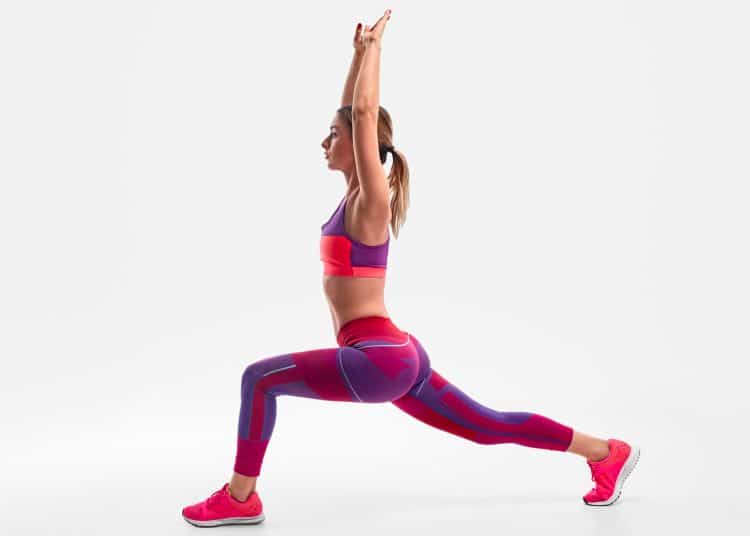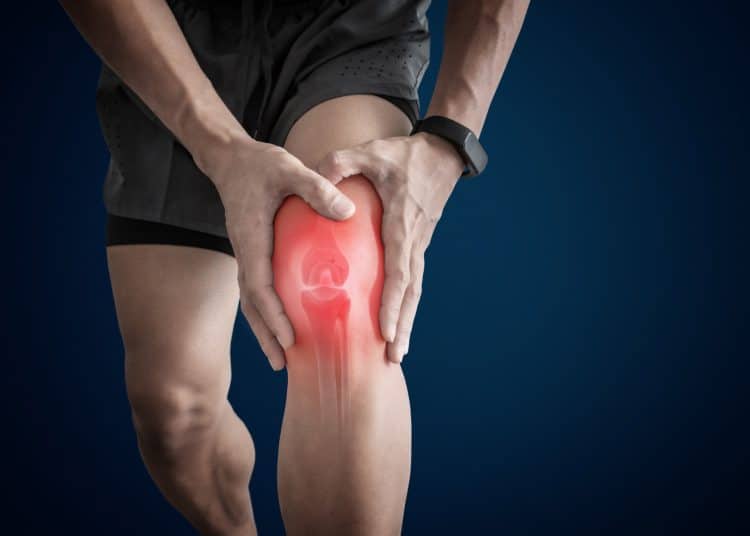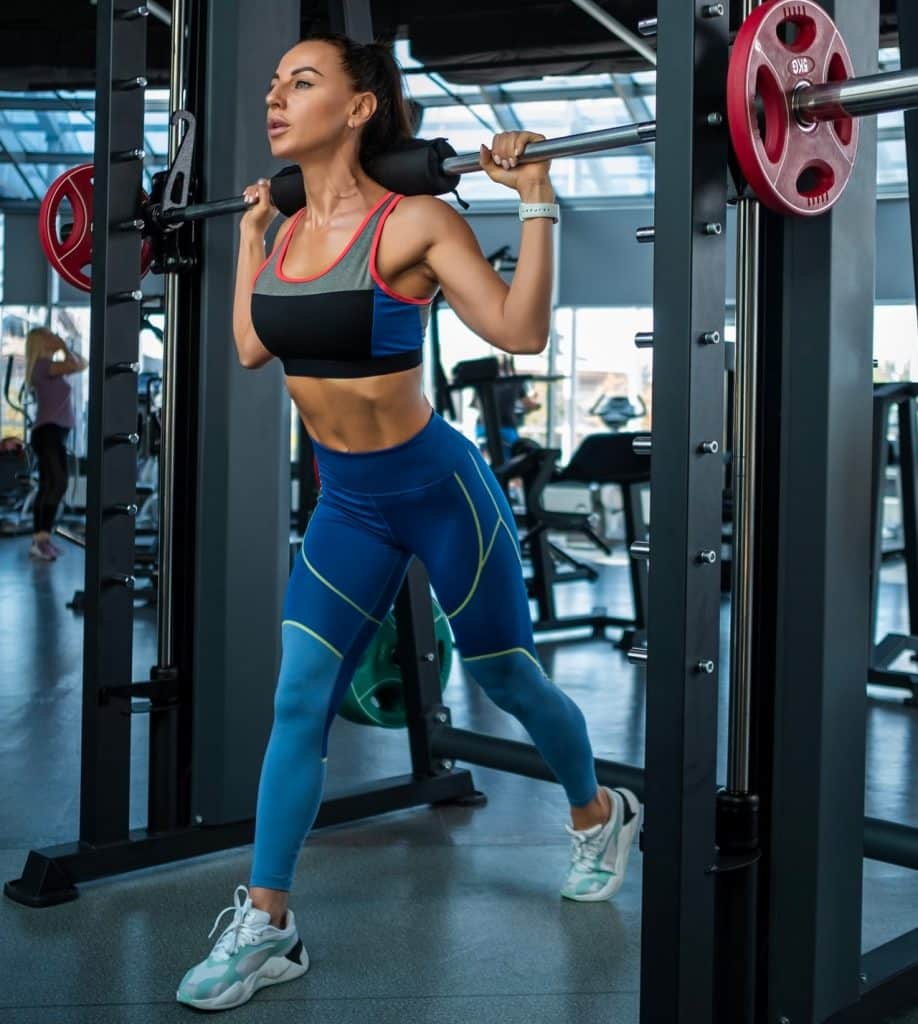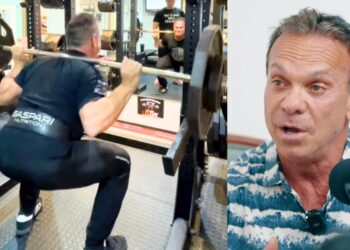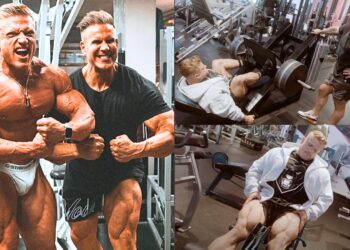Reverse lunges are an excellent exercise for building leg and glute strength while being easier on your knees. In this article, learn the proper form and benefits of reverse lunges and why they are a better alternative to forward lunges.
Unilateral lower body exercises like lunges are incredibly effective for building strength and muscle mass and fixing imbalances. However, seven years of working with several personal training clients have taught me that forward lunges can cause significant joint pain and discomfort in many people.
That said, you shouldn’t use this as an excuse to eliminate lunges from your training regimen. Research has found that reverse lunges (a closed kinetic chain exercise) can reduce shear forces in the knee joint compared to certain open kinetic chain movements like forward lunges, significantly limiting knee strain. (1)
Why Reverse Lunges are Easier on the Knees Than Forward Lunges
Lunges are among the most effective lower body exercises. This functional exercise can help build lower body strength and muscle mass and improve overall performance.
But let’s face it: forward lunges can lead to nagging knee pains in some people.
Level Up Your Fitness: Join our 💪 strong community in Fitness Volt Newsletter. Get daily inspiration, expert-backed workouts, nutrition tips, the latest in strength sports, and the support you need to reach your goals. Subscribe for free!
These are the reasons why reverse lunges are more knee-friendly than forward lunges:
Closed-Chain Exercise
Unlike forward lunges, reverse lunges are a close-chain exercise where the front foot remains in contact with the floor throughout the entire movement. Closed-chain exercises offer greater knee stability than open-chain exercises.
Limited Knee Travel
In my experience, most exercisers drive their front knee over their toes during forward lunges. This can cause significant knee pain, especially in people already dealing with joint issues.
The chances of extending the front knee over the toes are significantly lower during reverse lunges as the front leg is planted on the floor. The limited travel reduced stress on the tendons, ligaments, and knee joints.
Lateral Stability
Many exercisers wobble from side to side and move their arms as if walking a tightrope during forward lunges as they struggle to balance themselves.
Open-chain exercises are notorious for causing lateral instability. On the other hand, since reverse lunges involve a wider stance, it leads to better side-to-side stability and significantly reduces twisting forces on the front knee.
Limited Shearing Force
Think of the front leg in a reverse lunge as an anchor. During reverse lunges, most of your weight stays over the front leg throughout the exercise. Conversely, you must transfer your weight onto the front leg (and the knee) in a forward lunge.
This forward movement creates a shearing force as the tibia stops moving, but the femur continues to move forward. The front knee has to work overtime to stop moving forward. In the reverse lunge, this force is drastically reduced.
Reduced Patellofemoral Stress
Due to the movement mechanics (knee travel, lateral instability, and shearing force) of the forward lunges, your kneecap (patella) grinds against your thigh bone (femur) more than in reverse lunges.
Performing forward lunges with a fast rep cadence or heavier weights can place significant strain on your kneecaps and cause chronic knee pain.
Better Glute and Quad Engagement
Since forward stepping can cause instability, it can hamper glute and quad stimulation. Reverse lunges fire up the glutes and quads as you return to the upright position from the bottom of the range of motion. A greater glute and quads engagement also takes some of the load off the knee.
Easier to Control
Many of my personal training clients report that they find developing a glute and quad mind-muscle connection easier on the reverse lunges as they are easier to control due to their closed-chain nature.
Reverse lunges are also a more suitable exercise alternative for individuals with limited flexibility and mobility.
That said, you must consult your healthcare professional before starting a new training program, especially if you’re dealing with health issues.
Other Reasons For Knee Pain During Forward Lunges
Here are some other reasons why many exercisers experience knee strain during forward lunges:
Poor Technique
Forward lunges are an open-chain functional exercise that involves several moving parts. Performing this movement with a poor form, overly fast rep cadence, or more weights than you can handle comfortably can cause knee pain.
Lack of Mobility
Many lifters bang their rear knee on the floor while performing lunges. This can lead to knee pain and increases injury risk. This banging action is usually the result of a lack of mobility. Working on your mobility, especially if you have tight hips and ankles, allows you to control the descent and maintain tension on the target muscles.
Weak Muscles
Strong glutes, quads, and hamstrings are your knees’ best friends. They can take some tension off the knee joints. Conversely, if these muscle groups are lagging, it can lead to greater knee strain — and eventually pain.
Sometimes, knee pain can be an indicator of a more serious underlying issue. It’s not always wise to try to find ways to work around muscle or joint pains.
Level Up Your Fitness: Join our 💪 strong community in Fitness Volt Newsletter. Get daily inspiration, expert-backed workouts, nutrition tips, the latest in strength sports, and the support you need to reach your goals. Subscribe for free!
Consult your healthcare provider if you’re facing chronic joint issues. Work with them and a certified personal trainer to develop a suitable personalized training regimen.
Benefits of Reverse Lunges
Here are the benefits of reverse lunges for those with knee concerns and how they can be an effective substitute for forward lunges:
Reduced Knee Strain
Shear force is among the biggest culprits for knee strain during forward lunges. Backward lunges transfer that load as it changes the angle and reduces the pressure on the kneecap and surrounding tissues.
Many of my personal trainer colleagues program reverse lunges in the training program of individuals dealing with conditions like arthritis or meniscus tears. Consult a physical therapist or a doctor before starting training if you’re dealing with similar issues.
Improved Balance and Core Stability
Although reverse lunges involve stepping backward, they retain the balance and core stability-building benefits of forward lunges. Beginners should start with bodyweight reverse lunges, whereas advanced lifters can perform this exercise with additional resistance to bias hypertrophy and strength gains.
Strong Glutes and Hamstrings
I highly recommend that you stand in place and avoid walking backward while performing reverse lunges. Moving backward can increase your injury risk, especially in a crowded gym.
Performing this exercise in place delivers a more stable base, allowing you to lift heavier weights. Furthermore, since you’ll be stepping backward, it will lead to greater posterior chain muscle (glutes and hamstrings) stimulation.
Versatile
Whether you are a beginner, hobbyist lifter, or an elite athlete, you can scale reverse lunges to match your training objectives. Beginners should perform the bodyweight variation of this exercise. Hobbyist lifters can graduate to using dumbbells or kettlebells, whereas advanced athletes can opt for a barbell.
How To Perform Reverse Lunge: Proper Mechanics
Now that you know the benefits of reverse lunges for those with knee concerns, here is how to perform them using a picture-perfect form:
Setup
- Stand upright with a shoulder-wide stance. Keep your chest proud and back, neck, and head neutral.
- Take a controlled step backward with one leg and land on the balls of your feet. Your back leg should be slightly bent in this position.
- Feel free to adjust the stride length.
Pro Tip: Your feet should be hip-width apart to ensure a stable base.
Eccentrics
- Using a slow and controlled rep tempo, flex your knees to lower yourself until your rear knee is a few inches off the floor.
- Your front knee should track over your toes during the lowering phase. Letting them collapse inward can lead to knee strain.
- Maintain an upright torso during the eccentric phase to keep tension on the target muscles. Looking at the floor can lead to a forward torso lean and offset spinal alignment.
- Return to the starting position by pushing through the heel of the front foot.
Pro Tip: Avoid wearing running shoes with thick foam outsoles while performing this exercise, as it can lead to instability. Shoes with a stable heel, like Nike Metcons, can provide a solid base.
Who Should Choose Reverse Lunges Over Forward Lunges
Still confused if you should transition to the reverse lunges? This should help you make up your mind:
You Have a History of Knee Pain or Injury
Reverse lunges place significantly less stress on the knees than forward lunges because of the additional stability, limited knee travel, shearing force, and reduced patellofemoral stress. It also leads to greater glute and hamstring engagement, which can further limit tendon and ligament strain.
You are a Beginner
Reverse lunges offer more stability than forward lunges, which can help newbies drill the movement mechanics. On the flip side, it can help them perform forward lunges with a better form.
You Want To Improve Your Balance and Limit Injury Risk
Lower body overuse injuries are common in sports. Swapping forward lunges with backward lunges can limit the wear and tear on the knees and significantly limit injury risk.
You Have Hit a Plateau
Sticking to the same training regime for an extended period can lead to strength and muscle plateau. Switching your workouts by adding reverse lunges to the mix can help break through overhead ceilings.
Tips for Progression
Keep these tips front and center while trying to progress in the reverse lunges:
- Nail the Basics: Don’t bite off more than you can chew. Whether you are a novice or an advanced trainer, you must start with the bodyweight variation if you have never tried the reverse lunge before.
- Gradual Weight Progression: After you’ve drilled the bodyweight lunges movement mechanics, add light dumbbells or kettlebells for greater target muscle stimulation. Make the weight increments as small as possible. Ego lifting can lead to lower body joint pain, which beats the entire purpose of this exercise.
- Use Other Variations: Although reverse lunges are great, you don’t have to limit yourself to them. As you progress, incorporate other lunging variations into your training regime, including Bulgarian split squats and deficit and side lunges.
Remember, don’t hesitate to seek a personal trainer’s guidance if you feel stuck or if something doesn’t feel right.
Variations of the Reverse Lunge
Since we talked about reverse lunge variations in the last section, here are a few of them that you can incorporate into your lower body workouts:
- Weighted Reverse Lunge: This is the natural next step after you’ve mastered bodyweight reverse lunges. Hold onto a pair of dumbbells, kettlebells, or weight plates for this variation.
- Elevated Reverse Lunge: Position your rear foot on an aerobic step or weight plate before lunging. This increases the range of motion, which can lead to greater target muscle stimulation.
- Deficit Reverse Lunge: This is the mirror opposite of elevated reverse lunges. In this variation, you stand on an elevated surface and step down onto the floor before lunging.
- Reverse Lunge with a Twist: This variation is incredibly effective for folks who want to challenge their core. Perform a horizontal twist to the side with each lowering motion. This will engage the obliques and core stabilizers.
These variations will not only spice up your workouts, but they also target specific muscle groups, which can help fix imbalances and break through plateaus.
Conclusion
Mastering the reverse lunge can not only help prevent knee strain but it can also help improve aesthetics and build lower body strength. Reverse lunges transfer the tension from the front knee to the glutes and hamstrings, which can further lower the load on the joints.
Use the reverse lunge tips and movement mechanics mentioned above to bulletproof your lower body joints.
If you have any questions about forward or reverse lunges, drop them in the comments below, and I’ll be happy to help!
References
- Lutz, G. E., Palmitier, R. A., An, K. N., & Chao, E. Y. (1993). Comparison of tibiofemoral joint forces during open-kinetic-chain and closed-kinetic-chain exercises. The Journal of bone and joint surgery. American volume, 75(5), 732–739. https://doi.org/10.2106/00004623-199305000-00014
Interested in measuring your progress? Check out our strength standards for Bulgarian Split Squat, Side Lunge, Reverse Lunge, and more.

